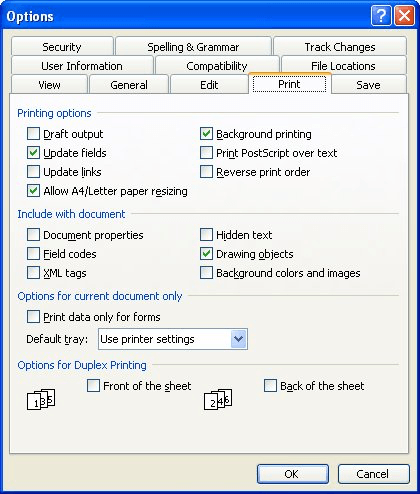Please Note: This article is written for users of the following Microsoft Word versions: 97, 2000, 2002, and 2003. If you are using a later version (Word 2007 or later), this tip may not work for you. For a version of this tip written specifically for later versions of Word, click here: Unwanted Cover Pages with Print Jobs.
Written by Allen Wyatt (last updated November 26, 2022)
This tip applies to Word 97, 2000, 2002, and 2003
Kaye has a new laptop. When she chooses to print a document, a cover sheet prints first. It lists the filename, directory, template, title, subject, author, and more. This sheet prints with every document printed. When she wants to print more than one page, it prints before each page. She wonders how to turn this off, as it is using a lot of printer ink.
When you start getting extra cover pages like this, there are really three things to check. First, you should check if your printer driver has a cover-sheet capability. You do this by displaying the Properties dialog box for your printer. Do this in Windows, not in Word. (If you are using Windows XP, click the Start button and then click Printers and Faxes. If you are using Windows Vista, click the Start button, click Control Panel, and then click Printer.) Right-click the printer's icon and choose Properties from the resulting Context menu. You'll see the printer's Properties dialog box, and you should make sure that the Advanced tab is displayed. The tab will look different for different printers, but on some printers there is a Separator Page button. Click the button and Window displays the Separator Page dialog box. (See Figure 1.)

Figure 1. The Separator Page dialog box.
Make sure there is nothing specified for a separator page, and then click OK.
If this doesn't cure the problem, then move on to the second place to check. This has to do with whether document properties are printed by Word with your document. Microsoft actually talks about this a bit in the Knowledge Base:
http://support.microsoft.com/kb/890897
To turn off this setting, follow these steps:

Figure 2. The Print tab of the Options dialog box.
If this still doesn't do the trick, then there is one last thing to try. Some printers have the capability to automatically add cover pages or separator pages between print jobs. (Large network printers in offices often do this.) You control this capability by using the setup functions on the printer itself. You may need to do some exploring and poking about in the setup menus, but you may very well find that the printer has this capability turned on. Use the setup menus for the printer to turn the feature off, and then try printing again.
WordTips is your source for cost-effective Microsoft Word training. (Microsoft Word is the most popular word processing software in the world.) This tip (588) applies to Microsoft Word 97, 2000, 2002, and 2003. You can find a version of this tip for the ribbon interface of Word (Word 2007 and later) here: Unwanted Cover Pages with Print Jobs.

Create Custom Apps with VBA! Discover how to extend the capabilities of Office 365 applications with VBA programming. Written in clear terms and understandable language, the book includes systematic tutorials and contains both intermediate and advanced content for experienced VB developers. Designed to be comprehensive, the book addresses not just one Office application, but the entire Office suite. Check out Mastering VBA for Microsoft Office 365 today!
Add a bunch of drawing objects to your document, and you may wonder how to make sure they all appear on a printout. How ...
Discover MoreWant to print on both sides of a piece of paper? Some printers have the capability to do two-sided printing ...
Discover MoreWant a printed record of the AutoCorrect entries you've created in Word? There is no built-in way to do it, but you can ...
Discover MoreFREE SERVICE: Get tips like this every week in WordTips, a free productivity newsletter. Enter your address and click "Subscribe."
There are currently no comments for this tip. (Be the first to leave your comment—just use the simple form above!)
Got a version of Word that uses the menu interface (Word 97, Word 2000, Word 2002, or Word 2003)? This site is for you! If you use a later version of Word, visit our WordTips site focusing on the ribbon interface.
Visit the WordTips channel on YouTube
FREE SERVICE: Get tips like this every week in WordTips, a free productivity newsletter. Enter your address and click "Subscribe."
Copyright © 2026 Sharon Parq Associates, Inc.
Comments